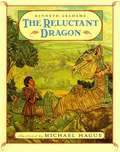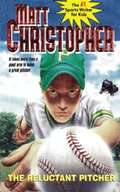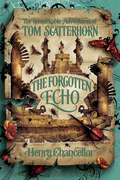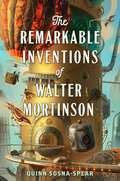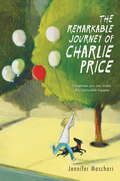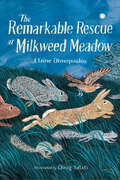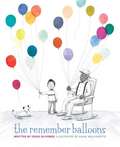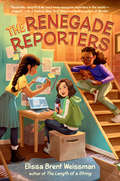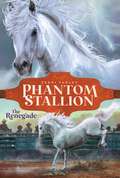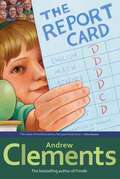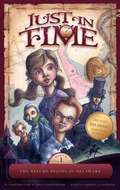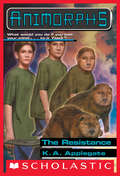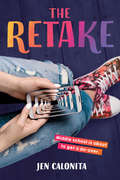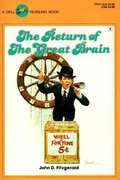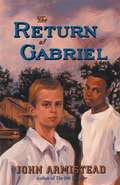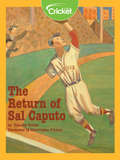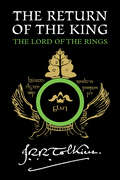- Table View
- List View
The Reluctant Adventures of Jimmy McMuggins (The Reluctant Adventures of Jimmy McMuggins #1)
by Andi AdamsDiscover a heart-warming story about facing your fears and embracing the unknown. Jimmy McMuggins would love to go and play with the other children, but there’s only one problem – he’s afraid of going outside. Jimmy spends his days dreaming of playing outside, wishing he could muster the courage to leave his house. But one day, a spunky young girl challenges him to step outside of the only world he’s known and try his hand at an adventure of his own… With beautiful pictures and a delightful tale about finding courage and daring to try new things, The Reluctant Adventures of Jimmy McMuggins is a wonderful and heart-warming story for children of all ages. Perfect for bedtime stories, group reading, and one-on-one, this book is sure to keep kids captivated, teaching them that it’s good to face your fears and not let worry hold you back.
The Reluctant Brownie (Fountas & Pinnell Classroom #Guided Reading Grade 4)
by Katherine Catmull Sophie EscabasseHow do you handle the mad scramble? Dylan's family can't get their act together in the morning, and it's driving him nuts. Plus, if he's late to practice again, Coach may bench him. How will he survive the morning chaos? NIMAC-sourced textbook
The Reluctant Dragon
by Kenneth GrahameWhen a dragon is discovered up on the Downs, the Boy is not in the least surprised. He's always known the cave there was a dragon cave, so it seems only right for a dragon to be living in it. The Boy decides to pay a visit to the cave, and he thinks he knows just what to expect. But this particular dragon is not a bit like the ones in fairy tales!
The Reluctant Pitcher: It Takes More Than a Good Arm to Make a Great Pitcher (Sports)
by Matthew F ChristopherWally Morris is a good right fielder, but Coach Hutter is trying to make him a pitcher. Wally is a lefty and has a strong arm and good aim. What he doesn't have is the desire to play the position. But how can he refuse? Coach Hutter once saved his life, and Wally feels he owes him. Then he meets Cab Lacey, a former ballplayer whose life story bears some resemblances to his own. Will Cab help Wally see that being true to oneself is sometimes more important than fulfilling another's dreams?
The Remarkable Adventures of Tom Scatterhorn: The Forgotten Echo (Remarkable Adventures of Tom Scatterhorn)
by Henry ChancellorTom's old enemy, Don Gervase Askary, is up to his evil tricks again and Tom knows he has to try and stop him. As he sets off on another exciting adventure, in and out of time and travelling to places far and wide, Tom encounters danger from every side. Things he sees in the future could have a devastating impact on his life and the lives of those he loves. But is the future set in stone? Or can Tom's actions now rewrite the future and make for a happier ending? As Tom sets out on a near-impossible mission, he is helped by friends old and new, but in the end it will all come down to him and whether he can defeat Don Gervase Askary and his beetle army. This breathtaking climax to the Tom Scatterhorn trilogy will grip readers from the first page to the last-get ready for a non-stop adventure!
The Remarkable Inventions of Walter Mortinson
by Quinn Sosna-SpearIn this sweeping and inventive debut novel that’s perfect for fans of Roald Dahl, Neil Gaiman, and Tim Burton, a prodigal inventor flees his home to find his destiny.In the humdrum town of Moormouth, Walter Mortinson’s unusual inventions cause nothing but trouble. After one of his contraptions throws the town into chaos, Walter’s mother demands he cut the nonsense and join the family mortuary business. Far off on Flaster Isle, famed inventor Horace Flasterborn plans to take Walter under his wing, just as he did Walter’s genius father decades ago. When a letter arrives by unusual means offering Walter an apprenticeship, it isn’t long before Walter decides to flee Moormouth to meet his destiny. Walter runs away in the family hearse along with Cordelia, the moody girl next door with one eye and plenty of secrets. Together they journey through a strange landscape of fish-people, giantess miners, and hypnotized honeybees in an adventure that will not only reveal the truth about Walter’s past, but direct his future.
The Remarkable Journal of Professor Gunther von Steuben
by Daniel SchwabauerThe Remarkable Journal of Professor Gunther von Steuben offers a unique approach to journaling for elementary and junior high students.
The Remarkable Journey of Charlie Price
by Jennifer MaschariA heartfelt, beautifully written novel of love, loss, and math--perfect for fans of Rebecca Stead and Sharon M. Draper. Ever since twelve-year-old Charlie Price's mom died, he feels like his world has been split into two parts. Before included stargazing and Mathletes and Saturday scavenger hunts with his family. After means a dad who's completely checked out, comically bad dinners, and grief group that's anything but helpful. It seems like losing Mom meant losing everything else he loved, too.Just when Charlie thinks things can't get any worse, his sister, Imogen, starts acting erratically--missing school and making up lies about their mother. But everything changes when one day he follows her down a secret passageway in the middle of her bedroom and sees for himself. Imogen has found a parallel world where Mom is alive! There's hot cocoa and Scrabble and scavenger hunts again and everything is perfect . . . at first. But something doesn't feel right. Whenever Charlie returns to the real world, things are different, and not in a good way. And Imogen wants to spend more and more time on the other side. It's almost as if she wants to leave the real world for good. If Charlie doesn't uncover the truth, he could lose himself, the true memory of their mother, and Imogen . . . forever.
The Remarkable Rescue at Milkweed Meadow
by Elaine DimopoulosThis timeless early middle-grade adventure about friendship and community will charm animal-loving fans of The Tale of Despereaux and Clarice the Brave. Illustrated by Caldecott winner Doug Salati. <p><p> Butternut lives in the burrows of Milkweed Meadow with her nine rabbit brothers and sisters. Together they practice strategies for survival and tell stories. With disastrous scenarios blooming in her mind, Butternut embraces the lesson of her families’ stories: stick to your own rabbit-kind. But after befriending an incorrigible robin and a wounded deer, Butternut begins to question what she has been taught. <p><p> When the three friends discover other animals in crisis, Butternut must decide whether she can help, rally her friends and family, and be as brave as the heroes in the stories she tells. <p><p> Beautiful and arresting black-and-white illustrations bring the animals to life in this heartwarming story about friendship, community, and doing what is right.
The Rembrandt Conspiracy (The Lost Art Mysteries)
by Deron R. HicksIn this standalone companion to The Van Gogh Deception, Art and Camille team up once again to solve a large museum theft, using one of the biggest heists in history to help them solve the case. Perfect for fans of Dan Brown and the Mr. Lemoncello's Library and Book Scavenger series. Something&’s brewing at the National Portrait Gallery Museum in Washington, D.C. twelve-year-old Art is sure of it. But his only proof that a grand heist is about to take place is iced mocha, forty-two steps, and a mysterious woman who appears like clockwork in the museum. When Art convinces his best friend, Camille, that the heist is real, the two begin a thrilling chase through D.C. to uncover a villainous scheme that could be the biggest heist since the Isabelle Stewart Gardner Museum theft in 1990. With a billion dollars&’ worth of paintings on the line, the clock is ticking for Art and Camille to solve the conspiracy.
The Remember Balloons
by Jessie OliverosJames has a bunch of balloons, each of which holds a special memory, but as his grandfather ages and loses his own balloons, James discovers that he is gaining new ones.
The Renegade Reporters
by Elissa Brent WeissmanWhen Ash gets kicked off her school's news show, she becomes a renegade reporter--and makes a big discovery about technology and her fellow students' privacy.Ash and her friends are reporters. They were ready to lead their school news show, The News at Nine, sponsored by Van Ness Media, when an unfortunate incident involving a dancing teacher, an irresponsibly reported story, and a viral video got them kicked off the crew. So Ash, Maya, and Brielle decide to start their own news show, The Underground News. And soon they stumble on a big lead: Van Ness Media, the educational company that provides their school's software, has been gathering data from all the kids at school. Their drawings, their journals, even their movements are being recorded and cataloged by Van Ness Media. But why? Ash and her friends are determined to learn the truth and report it.
The Renegade: The Renegade (Phantom Stallion #4)
by Terri FarleyThe beloved fourth book in the middle grade Phantom Stallion series about a girl, her horse, and the beauty of the American West returns with a brand-new, stunning cover and bonus material! Perfect for fans of Canterwood Crest and classic horse stories like Black Beauty and My Friend Flicka.When an ambitious rodeo contractor comes to town, Sam&’s worried. The woman wants to buy tamed mustangs from local ranchers, including Sam&’s dad, and doesn&’t seem to take no for an answer. Then Sam spots the Phantom&’s herd—without him. She&’s sure he&’s been captured by the rodeo, but how will she find him? And if she does, how can she set him free?
The Replacement
by Lindsey DugaA girl is possessed by a ghost yearning to be free in this brand-new spooky mystery by Lindsey Duga!Do the dead deserve another chance?Erin loves her new home in the country. She has a big bedroom that overlooks a beautiful garden, and there's even a treehouse in the backyard. Everything is perfect . . . except for the ghost.At first, the ghost is nothing more than a nuisance, pulling Erin’s hair, coloring on the walls, and getting Erin into heaps of trouble with her parents.But things become even stranger when Erin starts losing her memory. Sometimes it’s only for a few minutes, and other times it’s for a few days. It’s almost as if she’s fallen asleep!Erin is convinced the ghost has been taking over her body, but why? It’s up to Erin to figure out how to quell the ghost before it can get her into even more trouble—or worse!
The Report Card
by Andrew ClementsNora Rose Rowley is a genius, but don't tell anyone. Nora's managed to make it to the fifth grade without anyone figuring out that she's not just an ordinary kid, and she wants to keep it that way. But then Nora gets fed up with the importance everyone attaches to test scores and grades, and she purposely brings home a terrible report card just to prove a point. Suddenly the attention she's successfully avoided all her life is focused on her, and her secret is out. And that's when things start to get really complicated....
The Rescue
by Elizabeth FaucherFrom the Navy SEALs base in South Korea, several SEALs are captured by the North Koreans as they attempt security action. When the USA declines to rescue them, their teenage children step in.
The Rescue Begins in Delaware
by Carol Lynch Williams Cheri Pray EarlGeorge and Gracie begin their adventure in Dover, Delaware 1776. The kids are surprised to discover that one of them changes into an animal every time they travel, and this time Gracie is a horse. All the twins want to do is return a pair of antique school desks and search for their parents. But instead they find themselves in the middle of the American Revolution and end up helping Caesar Rodney make his famous ride into Philadelphia to vote "yes" for the Declaration of Independence. Crowe lands in Delaware, too, and he plans to take the time machine--with George and Gracie inside!
The Resistance (Animorphs #47)
by K. A. ApplegateThe Animorphs have to make the most important decision they've ever faced: Do they continue to fight the Yeerks in secret, or is it time to let everyone know there's a resistance? That the Animorphs exist and Earth does stand a small chance against the invasion.Jake knows that either choice is a major one, not something that a kid should be responsible for. But he's getting tired of the pressure. Even though he realizes his friends need him to be strong, he doesn't feel that way. In fact, he feels just the opposite. And Jake knows if he starts to lose it, the Animorphs are done...
The Respiratory System (A True Book)
by Christine Taylor-ButlerThis book introduces readers (Grades 3-5) to the respiratory system, explaining why and how people breathe, how each organ works, and how certain diseases can influence respiration.
The Retake
by Jen Calonita&“A book about a time-traveling app? I&’m in! Jen Calonita strikes again with a coming-of-age middle grade full of wit and a little bit of magic. &“ —Sarah Mlynowski, New York Times bestselling author of the Whatever After and Upside Down Magic series"A brilliant friendship story that champions kindness, resilience and the courage to challenge long held expectations - both of others and of yourself." --Lauren Myracle, co-author of the New York Times best-selling Upside-Down Magic seriesYou can retake your photos...but what if could redo moments in your life too? With one magical app, Zoe is able to do just that! A smart and funny twist on time travel from New York Times bestselling author Jen Calonita, for fans for Disney's Zapped and The Swap. Zoe knows that the only thing harder than middle school is losing a best friend. She and Laura used to do everything together from taking silly selfies, to joining all the same clubs together and even throwing surprise birthday parties for one another. But lately things have been weird between them. Now Laura will post a photo of her hanging out with other girls before responding to Zoe's simple text. She doesn't even want to sit with her at lunch anymore. Zoe is heartbroken--all she wants is for things to go back to normal.But then a magical app downloads on her phone...and things get even weirder! Suddenly Zoe can travel back in time to moments where her and Laura started drifting apart. It is like a dream come true. A chance for Zoe to mend their friendship. But as Zoe goes back to moments of middle school drama--sleepover games gone wrong, field trips with cliques and crushes, and school projects that bring on more-than-awkward encounters--she realizes that second chances don't always go as planned and that sometimes you need to trust the magic of new beginnings.The Retake is a picture-perfect look at tween friendship, that also explores more serious themes of social media pressure, bullying and what it means to be yourself."Jen Calonita puts a magical spin on all-to-real middle school drama. Warm, witty and wise, The Retakeis for anyone who has broken up with a best friend and wished they could go back to the way it used to be."—Megan McCaferty, author of True to Your Selfie and Jessica Darling&’s It List series"As addictive as your favorite app, you won't be able to put it down." - Stacy McAnulty, the author of The Miscalculations of Lightning Girl
The Return (Animorphs #48)
by K. A. ApplegateDavid, the traitorous Animorph, is back. When the Animorphs decided to give another human being the power to morph, it was one of their biggest mistakes. David tried to destroy them all -- and almost succeeded. Rachel and the others thought they'd seen the last of him when they trapped David as a nothlit, leaving him on a deserted island to live out his days as a rat...They were wrong.Rachel knows what a threat David is. He's cunning and dangerous. Worst of all, he knows their secrets. Now he's captured Rachel as part of his plan. David wants power. He wants money. But more than anything, he wants revenge...
The Return Of The Great Brain
by John D. FitzgeraldTom Fitzgerald, alias The Great Brain, is back, struggling to stay reformed now that his friends have threatened to ostracize him if he pulls even one more swindle. But his brother J. D. knows Tom's reformation is too good to be true, and as a reformed Great Brain makes for a dull life, J. D. is not altogether unhappy--or blameless--when his brother's money-loving heart stealthily returns to business as usual. Under the watchful eyes of parents and friends, Tom has to be craftier than ever, and indeed he is. Whether he's cleverly pulling an out-and-out swindle so as not to be caught or solving a train robbery and murder, Tom's Great Brain never fails.
The Return of Gabriel
by John ArmisteadIn the summer of 1964, a thirteen-year-old white boy whose best friend is black is caught in the middle when civil rights workers and Ku Klux Klan members clash in a small town near Tupelo, Mississippi.
The Return of Sal Caputo
by Timothy TocherAfter Lou's dad gets drafted to fight in World War II, father and son write many letters to each other—mainly about their favorite sport, baseball. Lou worries when those letters suddenly stop coming.
The Return of the King: Being the Third Part of the Lord of the Rings (The Lord of the Rings, Book #3)
by J. R. R. TolkienThe third volume in J.R.R. Tolkien's epic adventure THE LORD OF THE RINGS As the Shadow of Mordor grows across the land, the Companions of the Ring have become involved in separate adventures. Aragorn, revealed as the hidden heir of the ancient Kings of the West, has joined with the Riders of Rohan against the forces of Isengard, and takes part in the desperate victory of the Hornburg. Merry and Pippin, captured by Orcs, escape into Fangorn Forest and there encounter the Ents. Gandalf has miraculously returned and defeated the evil wizard, Saruman. Sam has left his master for dead after a battle with the giant spider, Shelob; but Frodo is still alive -- now in the foul hands of the Orcs. And all the while the armies of the Dark Lord are massing as the One Ring draws ever nearer to the Cracks of Doom.


